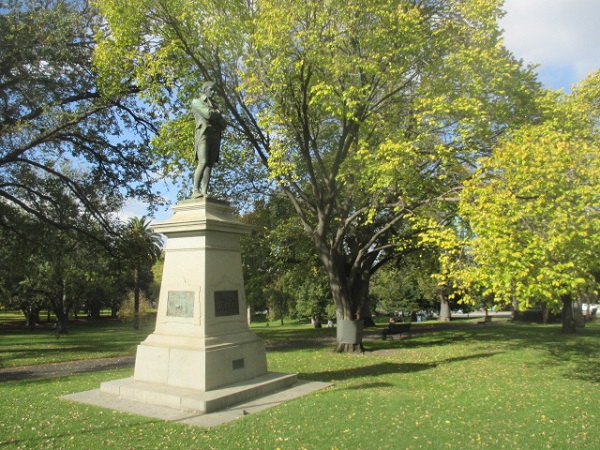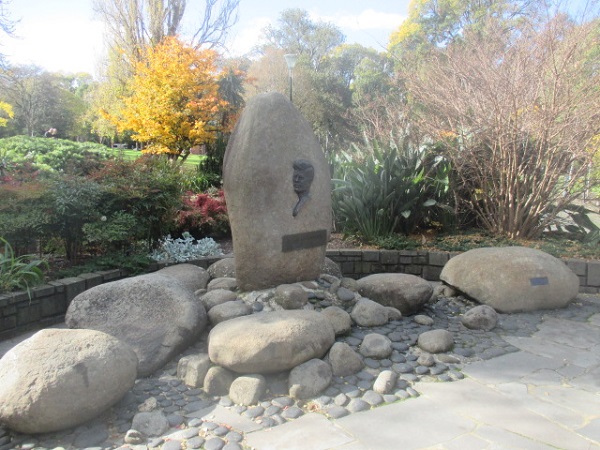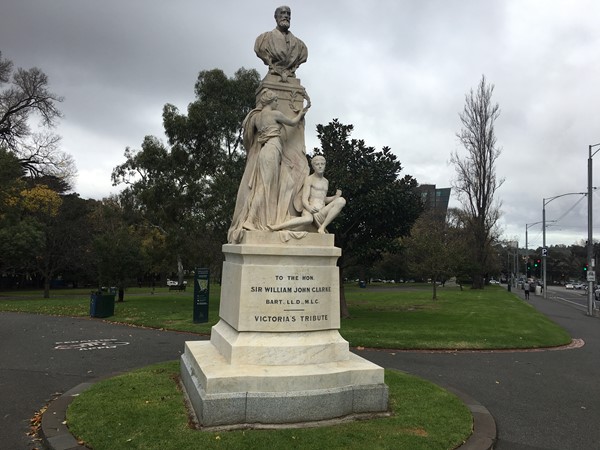Treasury Gardens (Central Melbourne)

.jpg)
The Treasury Gardens provide a tranquil green edge to Spring Street and are a picturesque segue to the Fitzroy Gardens, just over Lansdowne Street.
The gardens features include a Robert Burns memorial; an ornamental pond with a monument to President John F Kennedy; a memorial statue of Sir William Clarke; and a large embankment dotted with statues of Victorian politicians.
Review:
The gardens are very accessible being located on the eastern fringe of the Central Business District. There is a pond with ducks and a waterfall cascading into it, a statue of Robert Burns and a tribute to John F Kennedy. The park, which is reasonably small, has lovely grassy areas dotted with huge trees. On the Lansdowne Street side there is a lovely old building which is now a toilet block.
Photos:
Sculptures and Monuments:
Robert Burns Memorial

Bronze statue and plinth with granite pedestal by George Anderson Lawson (1903)
The best-known work of George Anderson Lawson is a statue of the famed Scottish poet Robert Burns, which stands at Ayr, in Scotland. A replica of this statue was cast in London for the City of Melbourne, and was erected in 1904 under the auspices of the Caledonian Society. Lawson's Burns is an imposing, larger than life-size figure depicted in tails and breeches, his posture and countenance suggesting a powerful spirit.
Born in 1759 in the village of Alloway, near Ayr, Robert Burns is one of the most celebrated figures in Scottish history. His work is of great literary importance and he is notable for his influence on the poetry and culture of Scotland. The son of a poor peasant farmer, Burns grew up in abject poverty. Yet recognising the value of education, his father contracted local teacher John Murdoch to tutor his son. From an early age it was apparent that Burns was a gifted scholar. His first published book, Poems, Chiefly in the Scottish Dialect (1786), immediately captured the hearts of the Scottish public, and was considered one of the greatest collections of poetry ever written. Burns became prolific, publishing many poems, among them his famous 'Auld Lang Syne'. He died in extreme poverty of rheumatic fever in 1796 at the age of 37.
Lawson's sculpture of Burns cost around 1000 pounds, and it is said that nearly every Scot in Melbourne contributed. The memorial symbolises the contribution Scottish migrants made to the early development of Victoria, with many of the first graziers and squatters in Gippsland and the Western District being of Scottish descent. The memorial remains a uniting symbol for Melbourne's Scottish community.
John F. Kennedy Memorial

Bronze bas-relief head set in granite boulder on landscaped site by Raymond B. Ewers (1965)
Following the 1963 assassination of John F. Kennedy, Ewers was commissioned to cast a bronze portrait of the former US president. This was set in a granite boulder and sited in the tranquil Japanese Gardens within Treasury Gardens. The ornamental lake was remodelled and a bridge built to the island where the monument would form the centrepiece. A paved area and a bronze flagpole were added, with the intention of reflecting Kennedy's final resting place at Arlington.
Besides averting a nuclear war with the Soviets over the 1962 Cuban missile crisis, the administration of John F. Kennedy spearheaded many progressive causes. While riding in an open-top limousine through the streets of Dallas, Texas, Kennedy was shot and killed by Lee Harvey Oswald on 22 November 1963.
Memorials to prominent British figures attest to Australia's links with Empire, but this is particularly significant for being a rare monument to an American. One of the memorial's plaques reads: 'This memorial signifies the grateful recognition by the citizens of this city for the service given by John F. Kennedy as President of the United States of America 1961-1963'.
Horse Hitching Post
Stone post by unknown artist (c. 1900)
The horse hitching post is an octagonal stone mounted on an octagonal base, on top of which is a metal ring. This is the hitching post that was originally installed outside No. 85 Spring Street. It is typical of the hitching posts found on Melbourne's streets prior to 1900.
Location: Opposite Flinders Lane in Treasury Gardens.
Sir William John Clarke Statue

By Edgar Bertram Mackennal (1902)
The bust of Clarke rests on a marble pedestal. Below the bust a woman is depicted offering a wreath (representing the State of Victoria) and a young man is depicted holding a scroll (representing education).
William John Clarke was born in Tasmania in 1831 and moved to Victoria in 1860. A philanthropist and wealthy pastoralist, he gave generously to the building funds for St Paul's Cathedral and Trinity College, and supported several other causes. He was actively involved in many areas of public life and was the first Australian to be made baronet. He died in 1897, stepping from a tramcar in Collins Street.
Following Clarke's death, a public meeting was held to determine how best to memorialise him. The monument, it was thought, must be 'of heroic size' and yet in keeping with Clarke's modesty. Mackennal sculpted the marble in London in consultation with Clarke's son-in-law and with the final approval of Lady Janet Clarke.
Location: Treasury Place in the north west corner of Treasury Gardens.
Location
2-18 Spring Street, East Melbourne 3002 View Map









